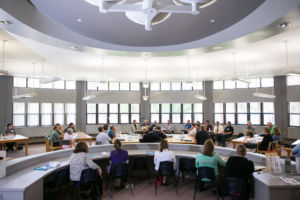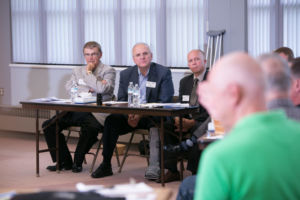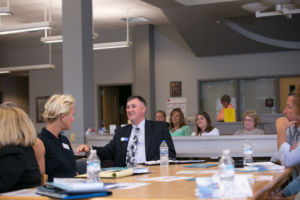Fergus Falls educators, manufacturers take on the skills gap
 Facing an increasing shortage of skilled employees to fill jobs vacated by retiring baby boomers, manufacturers, educators and civic leaders in Fergus Falls teamed up last year to outfit a state-of-the-art manufacturing lab in the local high school–funded entirely by private donations.
Facing an increasing shortage of skilled employees to fill jobs vacated by retiring baby boomers, manufacturers, educators and civic leaders in Fergus Falls teamed up last year to outfit a state-of-the-art manufacturing lab in the local high school–funded entirely by private donations.
This triumph of community initiative prompted several representatives of Center of the American Experiment (CAE) to join longtime local legislator Bud Nornes in July for a town meeting to discover how activists raised almost $320,000 for high tech improvements to the lab in less than six months.
“This is an example of what can happen when you have outstanding community leaders,” Ron Eibensteiner told an audience of more 60 people in the Roosevelt meeting room in the Fergus Falls secondary school. Eibensteiner, a Minneapolis-based venture capitalist, is board chairman at CAE. He also coauthored the chapter on job creation in the Center’s Minnesota Policy Blueprint, published last year.
He was joined by Peter Nelson, CAE’s vice president and senior policy fellow.
A panel of educators, manufacturers and community activists said the idea was conceived at the local Rotary when Evan Westra and Mike Westergard formed a working group to address the worsening skills gap. Westra owns West Tool and Design and Westerberg is director of manufacturing at StoneL.
Their conclusion: improve large, dimly-lit facility in the high school that had been accumulating dirt and grime since it was first acquired in the 1960s.
Fellow Rotarian Kim Embretson, then a development specialist at the Fergus Falls-based West Central Initiative, surmised the shop needed more than a paint job. “We needed something that would inspire students to say, “Whoa, this is really interesting.” Embretson spearheaded the fundraising.
New equipment would show students that modern manufacturing “isn’t working in grease and dirt, and dingy conditions. It is pretty modern and cutting edge, and a lot it is computer based,” according to Westergard.
Two high school technology instructors provided for a wish list of improvements
that included an array of CNC welding equipment in addition to plans to clean and repaint the facility, to install epoxy flooring, a new exhaust system, and new lighting. The price tag: close to $350,000.
In six months the group had commitments for $240,000. In addition, local manufacturers volunteered to loan their tech people to set up the machines, and help show the students how they work.
The teachers are still testing the curriculum, which includes fabrications, physical science, principles of engineering, math and a language arts class, which is be tailored to technical reading and writing.
But the bigger accomplishment, the teachers agree, is that they can now show students and parents the possibilities in manufacturing.
“We’re trying to meet the same standards in language and math and then tweak them to the technical side of the world,” says Jerry Ness, the school superintendent. “Our target audience here is anywhere from engineers to fabricators – anyone who would want do welding for a living, or someone who might want to design what the person is welding.”
Eibensteiner, who grew up on a farm in El Rosa, not far south from Fergus, said he knows first-hand the value of regional economic centers to the well-being of smaller communities.
“Manufacturers form the bedrock of many Minnesota communities. They offer high-wage, high-skill jobs that create economic opportunity and stability,” he said.
Minnesota’s 7400 manufacturers represent the largest private sector component of the state’s GDP, Eibensteiner told the audience. Half of them operate in Greater Minnesota.
State data demonstrate that they pay 21.6 percent higher than the average wage for all industries, he added.
But manufacturing’s impact on jobs goes deeper than that,” Eibensteiner said. “Each manufacturing job supports 1.9 jobs in other sectors of the economy. That means that 33 percent of all Minnesota jobs are directly or indirectly supported by manufacturing.”